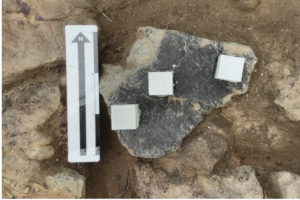Bridging Generations, Disciplines
Researcher Shelby Jones

Shelby Jones has been fascinated by the Earth’s magnetic field since high school. “When I first heard that the characteristics of Earth’s magnetic field could be preserved in rocks, I was 15 and was blown away,” she says. “The more I learned and worked in the field, the more my passion grew.”
After devoting the last 15 years to studying the topic, Jones now contributes her expertise as a researcher and educator at the Office of Archaeological Studies, while also completing her dissertation at Scripps Institution of Oceanography (University of California, San Diego). Archaeology has a reputation for poaching concepts and methods from other sciences, but Jones’s research is payback, transforming an extensive archive of obscure archaeomagnetic data into a valuable resource for the international geophysics research community.
“I love that I can combine my interests in geomagnetism and archaeology,” Jones says. “The idea that research in two very different fields can be mutually beneficial is the hallmark of modern scientific research.”
Office of Archaeological Studies Director Eric Blinman adds, “I never realized quite how valuable our efforts could be outside of archaeology.”
Archaeomagnetism is the study of the preserved magnetic signatures within archaeological materials. These signatures, when compared with models of variation in the Earth’s magnetic field over time, have proved to be a useful dating technique. Dr. Robert DuBois initiated the technique in the Americas in the early 1960s. In 1988, Dr. Daniel Wolfman established a Santa Fe laboratory for archaeomagnetic dating under the auspices of the Office of Archaeological Studies.
Now under the direction of Blinman, Jones and laboratory technician Jeff Cox, the OAS Archaeomagnetism Laboratory at the Center for New Mexico Archaeology is one of only a few sources for archaeomagnetic dating and dedicated archaeomagnetic research in the western hemisphere. After DuBois’ death in 2008, OAS staff and volunteers (with Museum of New Mexico Foundation donor support) rescued more than six tons of his data and samples that had been slated for disposal in the Oklahoma City landfill. Combined with Wolfman’s data, the archive goes far beyond dating—providing one of the richest data sets for geomagnetic field modelers in the world.
Thanks to the work of Jones, Blinman and Cox, the importance of the archive is attracting international attention and additional data contributions from other researchers.
Jones has published measurement data for more than 51,000 archived samples from nearly 5,000 archaeological features for use by international geomagnetic scientists. She has also brought sophisticated new tools to the OAS laboratory for sample processing and data analysis. Jones is bridging generations and disciplines. She’s poised to apply archaeological knowledge of pottery pyrotechnology to geophysical studies of the changing intensity of the Earth’s magnetic field. Cox is collaborating with Latin American researchers to publicize and build on DuBois and Wolfman’s extensive early work. Both efforts are supported in part by the Dr. Donald E. Pierce Endowment for Archaeology and Conservation.
Additional private gifts through the Foundation are needed for other laboratory projects. The latest is an innovative study of enigmatic burned rock features from east Texas. Using a hybrid of the best of paleomagnetic and archaeo-magnetic techniques, the OAS team employed the thermo-magnetic properties of the materials to propose how the features were constructed and used, and whether they were disturbed between use and excavation.“What I love about archaeology is that we are constantly solving problems, often by creatively applying concepts and techniques from other disciplines,” reflects Blinman. “Donor support allows us to take risks and venture into new world.”
This article is from Member News March 2022.
Image is a field photo of a rock component of an Archaic heating feature prepared for archaeomagnetic sampling. Photo by Terracon Inc.


Connect